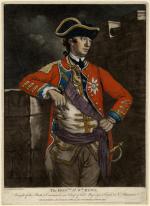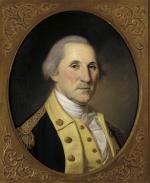![header=[Marker Text] body=[The battle ended just southwest of here at nightfall. With Howe and his troops holding the field, Washington's force withdrew to Chester. Although he was wounded, Lafayette helped to reorganize the retreating troops, and Pulaski's cavalry protected them from attack. ] sign](kora/files/1/10/1-A-CD-139-ExplorePAHistory-a0a3y9-a_450.gif)
Mouse over for marker text
Name:
Battle of Brandywine (Battle Ends)
Region:
Philadelphia and its Countryside/Lehigh Valley
County:
Delaware
Marker Location:
US 202 and 322 just S of Dilworthtown Road, 1.6 miles N of US 1, E of Chadds Ford
Dedication Date:
May 12, 1952
Behind the Marker
By 7pm on September 11, 1777, the combination of nightfall and Nathaniel Greene’s strong defense at  Dillworthtown convinced General Howe to call off his exhausted troops and allow the Continental Army to escape. “We only wanted a few more hours of daylight,” a British officer noted, “if we had, it’s the general opinion the rebellion must have been over.” Earlier in the day, Cornwallis’s attack from
Dillworthtown convinced General Howe to call off his exhausted troops and allow the Continental Army to escape. “We only wanted a few more hours of daylight,” a British officer noted, “if we had, it’s the general opinion the rebellion must have been over.” Earlier in the day, Cornwallis’s attack from  Osborne Hill and
Osborne Hill and  Knyphausen’s attack from the river, had driven the Americans from the battlefield. That night, Washington troops retreated on a twenty-mile march southeast towards Chester, PA under the cover the darkness.
Knyphausen’s attack from the river, had driven the Americans from the battlefield. That night, Washington troops retreated on a twenty-mile march southeast towards Chester, PA under the cover the darkness.
The 30,000 British, German, and American soldiers who fought during the Battle of Brandywine engaged in some of the fiercest fighting of the Revolutionary War. Washington left behind 1,300 killed, captured, and wounded men. Assessing British losses, General Howe reported roughly 600 killed, captured, and wounded soldiers, although in reality he suffered closer to 900 casualties. That night, dead and wounded soldiers covered the Quaker farms in the area, and since so many of the wounded were Americans, General Howe invited Washington to send surgeons to take care of the men. “The number of wounded Officers and Men of your Army in this Neighborhood, to whom every possible Attention has been paid,” wrote a British commander to Washington, “will nevertheless require your immediate Care, as I shall not be so situated as to give them the necessary Relief. Any surgeons you may chuse to send...[you] shall be permitted to send them.” Washington responded by sending several physicians, including Philadelphia doctor Benjamin Rush.
Benjamin Rush.
In addition to the human toll of the battle, the Continental Army also lost eleven valuable cannons during their retreat.
Even though the Continental Army had survived the battle and still stood between Howe and the rebel capital of Philadelphia, news of the battle panicked the city. The day after the battle, Thomas Paine published an essay The American Crisis, Philadelphia, September 12, 1777. “THOSE who expect to reap the blessings of freedom, must, like men, undergo the fatigues of supporting it,” Paine expressed. “The event of yesterday was one of those kind of alarms which is just sufficient to rouse us to duty, without being of consequence enough to depress our fortitude. It is not a field of a few acres of ground, but a cause, that we are defending, and whether we defeat the enemy in one battle, or by degrees,
Thomas Paine published an essay The American Crisis, Philadelphia, September 12, 1777. “THOSE who expect to reap the blessings of freedom, must, like men, undergo the fatigues of supporting it,” Paine expressed. “The event of yesterday was one of those kind of alarms which is just sufficient to rouse us to duty, without being of consequence enough to depress our fortitude. It is not a field of a few acres of ground, but a cause, that we are defending, and whether we defeat the enemy in one battle, or by degrees,  the consequences will be the same.”
the consequences will be the same.”
Although forced to evacuate the battlefield, Washington and the Continental Army felt that they fought honorably against the mighty British Army. Washington and his commanders believed that with better intelligence, they could have effectively defended the river and stopped Howe’s advance towards Philadelphia. From his location in Chester on the night of the battle, Washington wrote a letter to the John Hancock that suggested his men viewed their resistance on the battlefield as a moral victory. "Notwithstanding the misfortune of the day," Washington wrote, "I am happy to find the troops in good spirits." Washington and his army showed their determination during the Battle of Brandywine, not only to Howe and the British, but also any foreign ally who contemplated joining the American war effort. Despite the confidence Washington and his troops showed the ensuing days, Howe and the British continued their advance upon Philadelphia. Within a week after the battle, the Continental Congress evacuated to Lancaster, PA. On September 26, fifteen days after the Battle of Brandywine, the British occupied Philadelphia.
troops in good spirits." Washington and his army showed their determination during the Battle of Brandywine, not only to Howe and the British, but also any foreign ally who contemplated joining the American war effort. Despite the confidence Washington and his troops showed the ensuing days, Howe and the British continued their advance upon Philadelphia. Within a week after the battle, the Continental Congress evacuated to Lancaster, PA. On September 26, fifteen days after the Battle of Brandywine, the British occupied Philadelphia.
The 30,000 British, German, and American soldiers who fought during the Battle of Brandywine engaged in some of the fiercest fighting of the Revolutionary War. Washington left behind 1,300 killed, captured, and wounded men. Assessing British losses, General Howe reported roughly 600 killed, captured, and wounded soldiers, although in reality he suffered closer to 900 casualties. That night, dead and wounded soldiers covered the Quaker farms in the area, and since so many of the wounded were Americans, General Howe invited Washington to send surgeons to take care of the men. “The number of wounded Officers and Men of your Army in this Neighborhood, to whom every possible Attention has been paid,” wrote a British commander to Washington, “will nevertheless require your immediate Care, as I shall not be so situated as to give them the necessary Relief. Any surgeons you may chuse to send...[you] shall be permitted to send them.” Washington responded by sending several physicians, including Philadelphia doctor
In addition to the human toll of the battle, the Continental Army also lost eleven valuable cannons during their retreat.
Even though the Continental Army had survived the battle and still stood between Howe and the rebel capital of Philadelphia, news of the battle panicked the city. The day after the battle,
Although forced to evacuate the battlefield, Washington and the Continental Army felt that they fought honorably against the mighty British Army. Washington and his commanders believed that with better intelligence, they could have effectively defended the river and stopped Howe’s advance towards Philadelphia. From his location in Chester on the night of the battle, Washington wrote a letter to the John Hancock that suggested his men viewed their resistance on the battlefield as a moral victory. "Notwithstanding the misfortune of the day," Washington wrote, "I am happy to find the
Beyond the Marker






